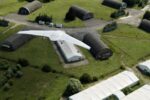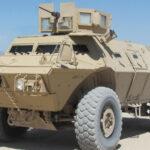At the Association of the United States Army (AUSA) Annual Meeting & Exposition 2025 in Washington D.C., American Rheinmetall unveiled a new configuration of its Skyranger air defense system. The showcased variant features the Skyranger 762 turret mounted on a GM Defense Infantry Squad Vehicle (ISV), offering a lightweight and highly mobile counter-unmanned aerial system (C-UAS) capability tailored to expeditionary and light forces.
Skyranger Family Overview
The Skyranger product line is Rheinmetall’s modular short-range air defense (SHORAD) solution designed to counter low-altitude threats such as drones, loitering munitions, and rotary-wing aircraft. The family includes two primary variants:
- Skyranger 35: Equipped with a 35mm Oerlikon Revolver Gun and integrated sensors/effectors for kinetic and non-kinetic engagement.
- Skyranger 30/762: Lighter-weight versions using smaller caliber guns (30mm or in this case, dual-mounted 7.62×51mm MGs) for highly mobile platforms.
The newly presented Skyranger 762 is focused on extremely light configurations suitable for rapid deployment units or special operations forces needing organic C-UAS protection without sacrificing mobility.
Integration with GM Defense Infantry Squad Vehicle
The platform selected for this configuration is the GM Defense ISV—a light tactical vehicle based on the Chevrolet Colorado ZR2 pickup truck chassis. Originally developed under a U.S. Army contract to transport nine-soldier infantry squads rapidly across difficult terrain, the ISV emphasizes speed and off-road agility over armor protection.
Key characteristics of the ISV include:
- Curb weight under 2,300 kg
- Payload capacity of ~1,000 kg
- Air transportable via CH-47 Chinook or UH-60 Black Hawk helicopters
Mounting the Skyranger turret on this ultralight chassis demonstrates Rheinmetall’s intent to offer scalable SHORAD solutions even for airborne or light infantry formations that traditionally lack integral air defense assets.
Capabilities of the Skyranger 762 Turret
The Skyranger 762 turret is armed with dual FN MAG-style belt-fed machine guns chambered in NATO-standard 7.62×51mm. While this caliber lacks destructive power against larger aircraft or hardened targets, it is sufficient to disrupt or destroy Group I/II UAVs—especially commercial quadcopters and fixed-wing drones used in ISR or kamikaze roles.
Main features include:
- Electro-optical/infrared (EO/IR) targeting suite with automatic tracking
- LIDAR-based cueing and target classification algorithms powered by AI-assisted threat libraries
- 360° coverage with high slew rates for fast target acquisition
- Optional integration with soft-kill effectors such as RF jammers or dazzlers
- C4I compatibility with NATO-standard BMS interfaces (e.g., Link-16)
This makes it well-suited for layered C-UAS roles where it can complement higher-end kinetic interceptors like Stinger missiles or directed energy systems by engaging swarms or low-cost threats economically.
Tactical Use Cases and Operational Implications
The integration of a SHORAD/C-UAS turret onto an ultralight vehicle addresses an urgent doctrinal gap exposed in recent conflicts such as Ukraine—where small drones have proven devastating against unprotected infantry formations. For U.S. Army IBCTs (Infantry Brigade Combat Teams), which currently lack organic air defense below battalion level, systems like Skyranger on ISVs could provide squad-level overwatch against drone threats during maneuver operations.
This approach aligns with emerging U.S. Army doctrine emphasizing distributed operations and multi-domain survivability. Key advantages include:
- Tactical mobility: Enables shoot-and-scoot tactics while keeping pace with dismounted troops.
- Sustainability: Uses common fuel/logistics chains due to commercial base vehicle design.
- Affordability: Low-cost per shot compared to missile-based systems; ideal for drone swarms.
- Crew safety: Remote operation possible; low signature reduces exposure risk.
AUSA Debut Signals Market Positioning Strategy
The timing of this debut at AUSA suggests that American Rheinmetall is positioning the Skyranger family not only as a NATO-compatible SHORAD solution but also as part of its broader push into U.S.-based production and integration efforts. This follows previous announcements about its participation in programs like XM30 Mechanized Infantry Combat Vehicle (formerly OMFV) alongside General Dynamics Land Systems and other partners under Team Lynx USA.
The move also reflects growing demand across NATO allies for agile C-UAS solutions that can be rapidly fielded without requiring entirely new vehicle fleets or extensive training pipelines. By leveraging existing platforms like the GM Defense ISV and modular turrets like Skyranger, Rheinmetall aims to offer plug-and-play options adaptable across multiple force structures—from SOF teams to conventional brigades operating in contested environments where drone saturation is expected.
Looking Ahead: Future Variants and Integration Paths
Ahead of formal procurement interest from U.S. services or allies, future iterations may incorporate additional effectors such as laser weapons (as seen in other Skynex family members), radar-guided fire control modules, or even loitering munitions launchers mounted co-axially with the gun system. Integration into layered IADS networks via tactical data links will be key to maximizing effectiveness against both autonomous swarms and coordinated drone attacks guided by EW-resistant protocols.
If adopted widely—whether by airborne units needing expeditionary C-UAS coverage or mechanized units seeking cost-effective point defense—the Skyranger-on-ISV concept could become an important node within future SHORAD architectures blending kinetic guns, missiles, jammers, lasers, and AI-enabled targeting into cohesive kill chains from platoon level upward.










